Joe Ray: In His Own Words
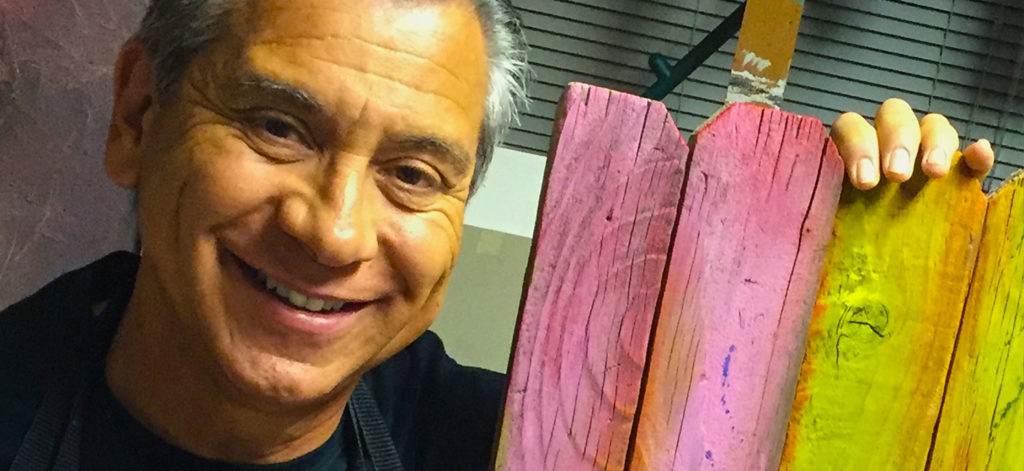
Sep, 29, 2020
ArtistsCommunityPhxArtist Spotlight
Joe Ray: In His Own Words
“I prefer living in color,” said renowned artist David Hockney, and after experiencing the work of creative entrepreneur and artist Joe Ray, you might say Ray lives by the same creed. The colors in Ray’s art are rich and vibrant, drawing you into compositions that are steeped in personal history, the tales of which span Mexico all the way up to western Arizona. There’s a life to his art that exists both within it and independently of it, referencing cultures that make Arizona what it is, and Joe Ray who he is.
With a BFA from Arizona State University, Ray is the creative director at Maximo Branding and an artist member of XICO Arte y Cultura, a non-profit supporting Latinx and Indigenous artists. We sat down with him to discover how he came to be the artist and person he is today.
Here’s Joe Ray, in his own words.
“My work speaks to the Mexicano, the Chicano, the Latinx, the Native, and the Gabacho.”
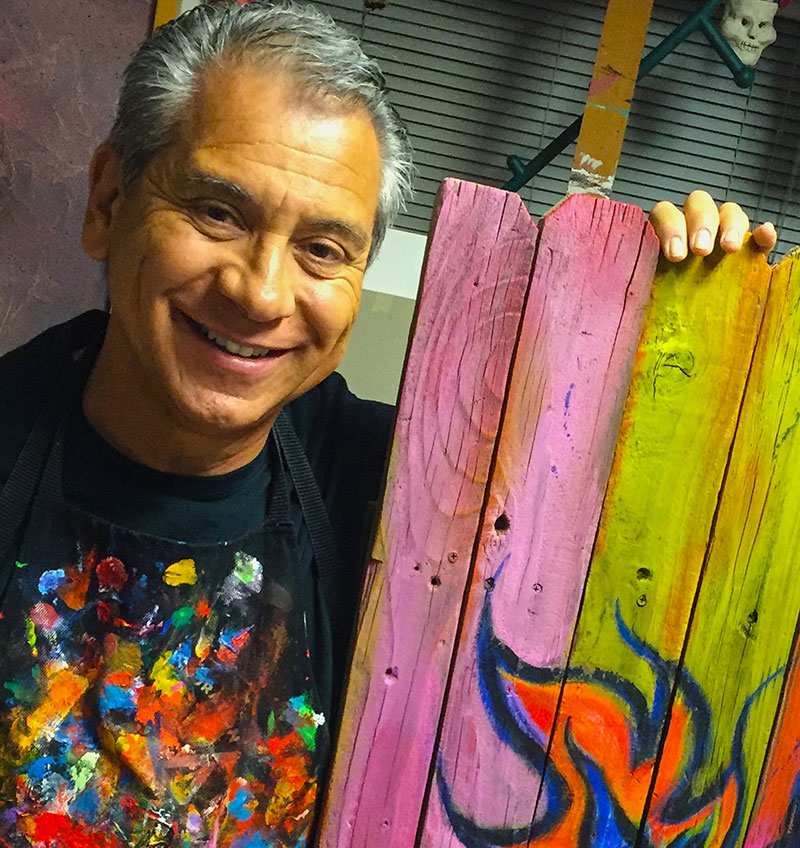
Joe Ray. Courtesy of the artist.
PhxArt: Tell us about who you are and how you came to be an artist. What was your first inspiration?
Joe Ray: I was born in San Luis Río Colorado, Sonora, Mexico and grew up in western Arizona on the Colorado River Indian Tribes (CRIT) Reservation in Poston. I learned to speak English in a proficient manner when I was about 6 years old. I was held back in 1st grade because I couldn’t speak or understand English very well, and that sort of lit a fire under me.
I have always drawn pictures, but going back to elementary school, comic books sparked my desire to become an artist. I enjoyed the action, the visual sound effects, and the dialogue bubbles. For me, comics were a combination of storytelling and drawing, so they were my bliss. My teachers hated comics and said they’d rot my brain, but as a kid, I enjoyed going to the library to read them and other books because they fired up my imagination.
I was also inspired a lot by Lucha Libre, the old-school masked Mexican wrestlers. I remember going to Mexico and heading to the movies with my cousins to watch El Santo on the big screen. Santo, Blue Demon, Mil Máscaras, and others were like superheroes from comic books, but they were real guys!
I also was exposed to creative inspiration and different types of art making in the area where I grew up. It was an agricultural valley with lots of migrant workers and people from all over Mexico and the Southwest, and the reservation was home to four different tribes. All of this made for a diverse upbringing, with many styles of Mexican food from different regions and kids with different stories to share. I worked in the fields from the time I was 10 years old, and even though summers were insanely hot, I was working beside my friends and making new friends. All of our imaginations were fueled by our conversations and what we learned from each other, in addition to what we made up.
A number of these friends of mine knew how to draw really well, too. A couple of my Native friends had a parent or an older sibling who did silversmithing, weaving, or Kachina carving. But from what I can recall, there was no one around who was a professional artist or who created art with a continuous passion. I personally wanted to be an artist, and I didn’t. I guess I just had no idea how to go about it.
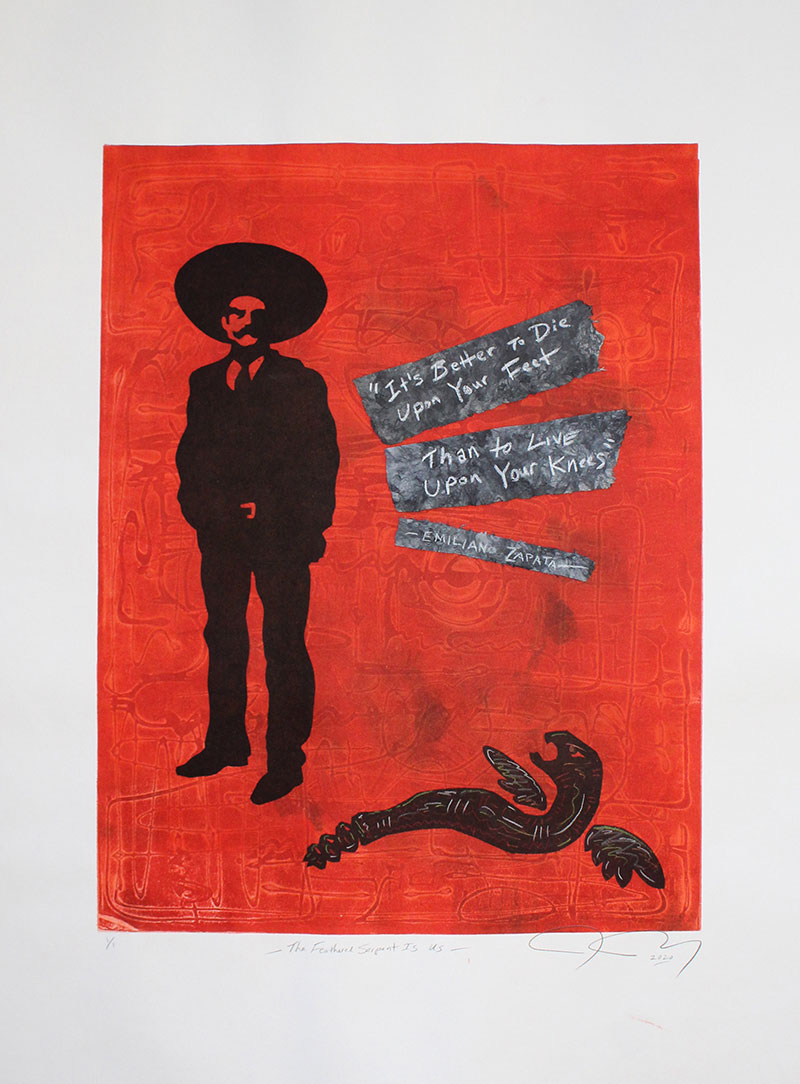
Joe Ray, The Feathered Serpent is Us, 2020. Monoprint on paper. Courtesy of the artist.
PhxArt: What was the turning point for you in knowing you wanted and could be an artist?
Ray: In high school, I had a great art teacher, Claude Thorn. He was an ex-Marine who was incredibly talented and soft spoken, but he was tough and knew how to teach teenagers (no matter how rebellious) to make stuff. He didn’t take any slacking or goofing off.
Mr. Thorn became the guiding force in my life who would help get me to college. My senior year, he asked me if I was interested in an art scholarship. I hadn’t really given serious thought to how I was going to go to college, and neither had my parents. We just knew I needed to go. I told him I didn’t really want to pursue art as a career because I didn’t want to starve and I could make more money driving a tractor or doing other farm work. He told me that a scholarship was an entry point—it could get me to a junior college (Arizona Western College in Yuma), and from there, I could decide what path I wanted to take. But at least I’d get my foot on a college campus and see what possibilities existed.
Mr. Thorn ended up being right, and as a mentor and friend, he would help start me on my art path. I am forever grateful for him, and we remained in contact off and on until his death in 2007.
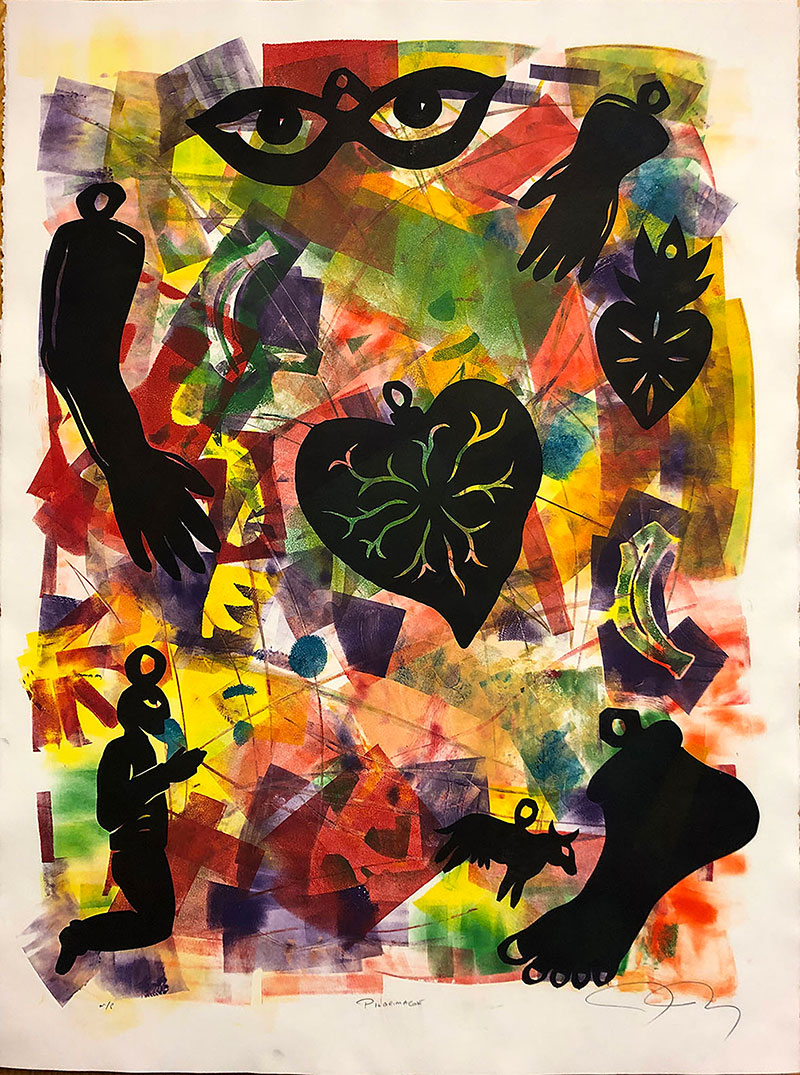
Joe Ray, Pilgrimage, 2018. Monoprint on paper. Courtesy of the artist.
PhxArt: Does the artwork you create today draw inspiration from your personal history?
Ray: Yes. My background, my upbringing, and my relationship with Mr. Thorn have definitely shaped my artistic vision. My work evokes color and passion, and most of it speaks to a bi-cultural perspective that reflects the Arizona-Mexico region and the people living there, as well as a contemporary Chicano perspective. My work speaks to the Mexicano, the Chicano, the Latinx, the Native, and the Gabacho.
PhxArt: In which media do you prefer to work?
Ray: I’m a painter, printmaker, sculptor, and storyteller. Printmaking is a blast because it’s a group sport—it takes place with other artists present. Not having a press of my own, I go wherever a press resides. Much of my printing takes place at Xico, where I’ve taught workshops the past couple of summers.
Storytelling is something I’m relatively new at, but I love it also. I enjoy listening and sharing. It’s especially invigorating to see the expressions and responses from audience members. I like to say it’s like painting pictures with words. Words become the images and the colors.

Joe Ray, Con Energia (With Energy), 2019. Monoprint on paper. Courtesy of the artist.
PhxArt: Who are your greatest artistic influences?
Ray: On the fine art side, my favorites were always Diego Rivera, Rufino Tamayo, and Pablo Picasso. Then there’s Frida Kahlo, Georgia O’Keeffe, Andy Warhol, Jean-Michel Basquiat, Julian Schnabel, and David Hockney. I like color—it sets the mood.
I’m also inspired by unknown artists, namely the creators of cave drawings and petroglyphs, pre-Columbian sculptors and builders, and whoever created the incredible Nazca Lines.
Much of my artistic drive comes from the work of graphic designers and illustrators Milton Glaser and Seymour Chwast. And then inspiration for me also comes from the music I’m listening to, including the visually compelling tracks of Pink Floyd, Jackson Browne, Lila Downs, War, and other rock-and-roll and Motown artists.
PhxArt: What is something you’re currently working?
Ray: My wife and business partner, Christine, and I are in the final stages of putting together a collection for Helios Education Foundation’s new campus in Phoenix. This was a big honor and a fantastic project for me. It involved developing an overarching concept for the campus’ art and spaces, together with the client and the architects. I also had the opportunity to work with local artists whose work I admire and whom I know personally.
Additionally, I just finished collaborating with clay artist Rosemary Lonewolf from New Mexico. Together, we created one of five large-scale sculpture installations on the campus. This project is called Gathering Towers and consists of five individual standing structures, each with a different theme (Corn/Maize, Stone, Flora, Butterfly/Dragonfly, and Bird). Each tower is made of “stacked” ceramic and glass elements that light up from the inside with LEDs. They’re like giant glow sticks. Three of the towers are eight feet tall and two are 15 feet tall. It was quite an undertaking and labor of love, and I’m excited to take on something of that scale again to continue exploring that realm.
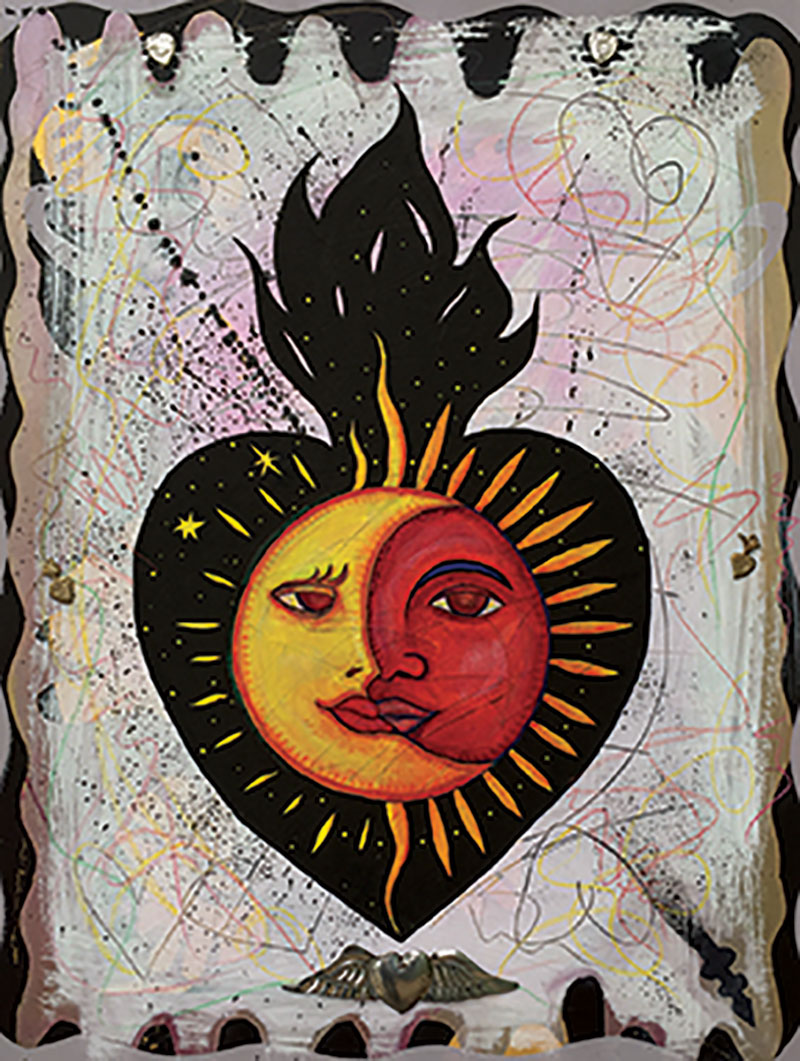
Joe Ray, Entre la Luna y El Sol (Between the Moon & Sun), 2015. Mixed media on paper. Courtesy of the artist.
PhxArt: You’ve worked in Arizona for a long time now. How has the art scene changed?
Ray: The downtown Phoenix scene has blown up and is facing gentrification again. When I was part of Movimiento Artístico del Rio Salado (MARS) in the early to mid-1980s, there wasn’t a whole lot of art downtown. Or there were a few spaces with numerous artists, but it was all low key. Then came the Suns arena and the development of that area, and it pushed the artists out.
The nice thing about art groups like MARS was that they were peer groups that inspired and challenged artists. As a young artist, I was forced to elevate my thinking, especially as I started my design career and moved toward a career as an artist. Thanks to MARS, I felt I had support and mentorship, and I was able to make connections and collaborate with other artists and art groups outside of Arizona.
PhxArt: What’s some advice you’d give to artists who are just starting out?
Ray: Find and hang out with those who challenge, encourage, and inspire you. Find your kindred-spirit group, your new family, your tribe, and connect or reconnect with them. Challenge yourself and each other.
Create but also take breaks. Center yourself, meditate, contemplate, and re-charge your batteries. Be thoughtful before you respond to anything—don’t be reactive. Apply for any available opportunities.
Make friends outside of your peer group, including those of different ages, genders, races, and backgrounds. Ask questions and brainstorm with those outside of your usual circles.
If you have goals, take a few minutes each day to move toward them. Humor yourself with the crazy shit that crosses your mind. On a webinar the other day, a creative director said something along the lines of: “Everything you want to do in your 20s, 30s, and 40s is all stuff you wanted to do when you were 5 or 6 years old.” I loved that. It’s an eye opener. As children, we’re all creative—we’re all artists. Then we lose it as we go through conforming phases. I think we too eagerly open those doors of conformity. But don’t do it too early on. There’s plenty of time for that later.
I’d also tell young artists to be sponges. Learn as much as you can from the world around you. Take chances, but don’t confuse being wild and crazy with self-destructive behavior. Technology offers a great opportunity to learn so much, but don’t let it overtake your life. Go out and actually interact and experience things.
Ask yourself how you want to come out of this pandemic. What was your starting point, your reset point, your creation day? What did you learn? Who will you be, and what will you do after this is over?
And finally, always be grateful to those who support you and your art. Don’t take that appreciation and generosity too lightly. Show gratitude.
See more
To discover more work by Joe Ray, visit joeray.com, follow him on Instagram and Facebook, or check out xicoinc.org.
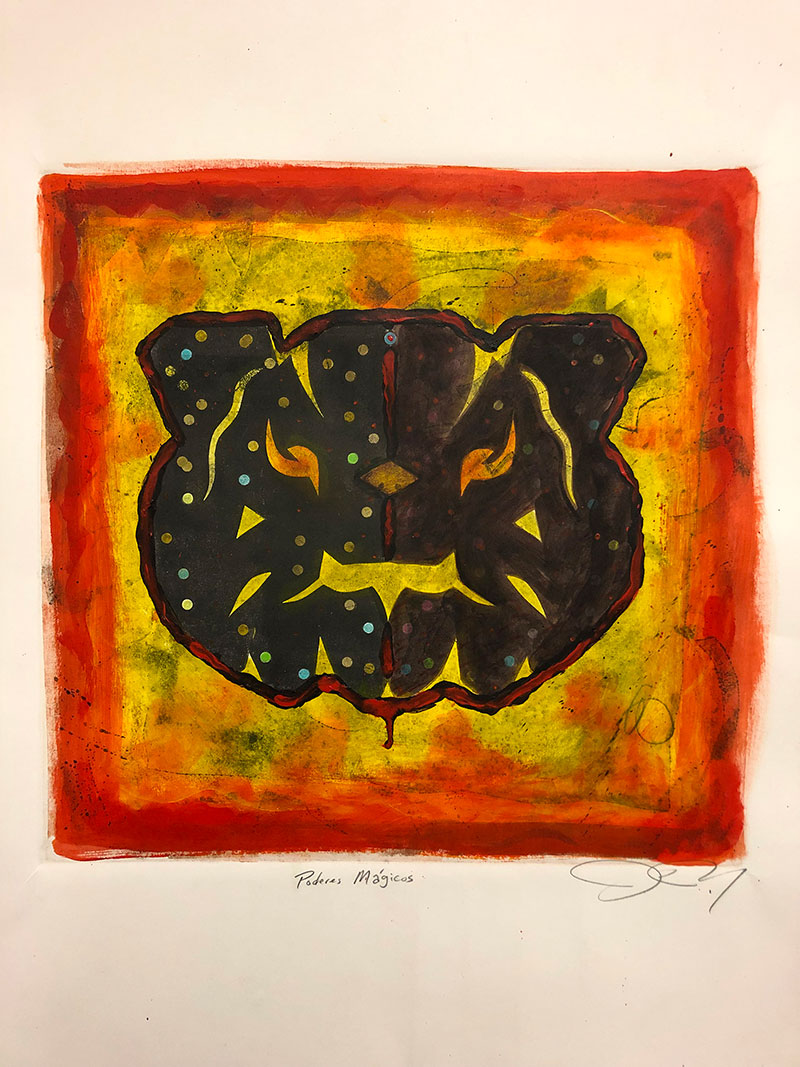
Joe Ray, Poderes Mágicos (Magical Powers), 2017. Mixed media monoprint. Courtesy of the artist.
#CreativeQuarantine
We’re curious how creatives are navigating the time of coronavirus. Joe Ray shares what’s giving him life as a creative during quarantine.
Ray: Early on in the pandemic, I spent a lot of time in the studio and, between March and late June, created a body of work of about 25 pieces that really had nothing to do with quarantine or what was going on around me, although some friends disagreed and found them relevant to the current times. I ended up doing a Facebook Live event, where I spoke about each piece and had a sale. The event was called Iso-Cuarentena, and it was a lot of fun. At that moment, I felt creatively and intimately connected with a virtual audience through my art.
We’re living in unprecedented and uncertain times, and we should be seeking out new ways to be creative and create something. We may not stabilize the world, but we can find ways to stabilize ourselves and get centered.
Categories
What can we help you find?
Need further assistance?
Please call Visitor Services at 602.257.1880 or email